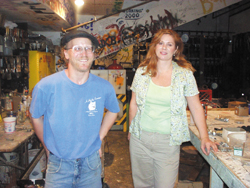Welcoming the back-to-school rush of students this week, the bookstore lines, and the registration gone awry is Arts on the Point: the sculpture park at UMass Boston.
Arts on the Point is a non-profit, privately funded program, supported by artists, collectors, businesses, and institutions. The founder and first director of Arts on the Point is Paul Tucker, esteemed Professor of Art at UMass Boston since 1978. Arts on the Point includes numerous works that have been donated, lent, or constructed by supporters according to artists’ designs. The works express the human quest for self-discovery and fulfillment.
Wendy Baring-Gould, director of education and outreach programs, has worked for Arts on the Point for two years. She currently provides tours for students and staff, which leave from the Harbor Art Gallery, located on the first floor of McCormack. While discussing the works Baring-Gould adds, “Tucker wanted them for this campus to humanize and stimulate the environment.”
There are seven works on campus: Huru, Los Gatos, The Gods, Hero in the Evening, coffins from Ghana, Double Cubes, and Stinger.
Have you ever wondered about that huge, industrial monster that greets you as you turn into the parking garage? Surprise, it’s art. Its name is Huru, meaning “hello” and “goodbye” in aboriginal Australian. Huru weighs in at 30, 000 lbs and, with its out-stretched arms that sway with the wind, does indeed welcome all.
The creator of this piece is Mark DiSuvero, who used innovation in creating pieces of art from found, recycled materials forming something more.
Originally, DiSuvero, worked as an elevator repair man until he was crushed and paralyzed. DiSuvero learned to weld in his wheelchair using a crane to bend metals.
The next piece is Los Gatos, meaning “the crocodiles” in Spanish. This piece is situated outside of the Administration building. It was made by Luis Jimenez, a Texan born in 1940. Jimenez created his art with a strong emphasis on the Chicano community, and a political focus on Latino experiences in the U.S. He is remembered for his Steel Worker piece, which was displayed here at UMass and is currently on exhibit. Jimenez’s works are constructed with fiberglass, and then painted over with bold, neon colors.
The Gods, created by William Tucker, who sit outside the Science building, look more like three big globs of clay. Initially the British artist came to the U.S. and began modeling heads from clay. His pieces however, become larger and rougher to the extent where he had to use his entire body to shape them.
Each of the three pieces is a member of the original five-person family who represent the children of Ouranus and Gaia, the mythological Greek parents of Cronos and Rhea, and the grandparents of the commonly known as Zeus and Hera. The smallest figure is Ouranus, the god of the heavens. The others are Cronos and Rhea, two of his children. The artist began these works by making swift, intuitive clay models, without drawings, that were small enough to hold in his hand and gradually grew into something more symbolic.
Hero in the Evening, the white bulging mass of clay, was also created by William Tucker. It is located inWheatley and McCormack. Paul Tucker admired these works and invited the Hero and The Gods to come live on campus.
Next are the Ghana coffins, which many have seen but few have understood. In Africa, wooden coffins were often carved in motifs significant to the deceased.
With the disruption of WWII, planes flew over and stopped at airbases to refuel on their way to Europe. An old woman whose grandson was a carpenter, who also loved to carve, wished she could have the chance to ride on a plane. When she died, not having had her wish fulfilled, her grandson carved her a coffin in the shape of an airplane. More requests came for specialized coffins and they are still being used for funerals in Ghana today. Families and close friends would choose the design for the deceased, honoring them and their achievements.
Directly outside of Wheatley are the Double Cubes made from fiberglass and painted black. The artist, Sol Lewitt was fascinated with cubes his entire artistic life. All of his work has involved the geometric design of the cube, and all the ways its form can vary.
The final piece of art is the latest addition to the Sculpture Park. Its name is Stinger, and is positioned adjacent to the harbor. This setting highlights the industrial object, which was envisioned from a black stove, enveloped by nature. The artist, Tony Smith was influenced by the modular stacking of the Pueblo Ruins in New Mexico. Stinger has an area 33sq ft., height of six feet tall, and weighs 36,000 lbs.
The Arts on the Point sculpture park tours will happen intermittently throughout the year. The schedule will be posted at the McCormack Art Gallery. An art show featuring Paul Tucker and his draftsmanship is being planned for the spring. It will be held at the Healey library, on the fifth floor. Enjoy the show!





















































